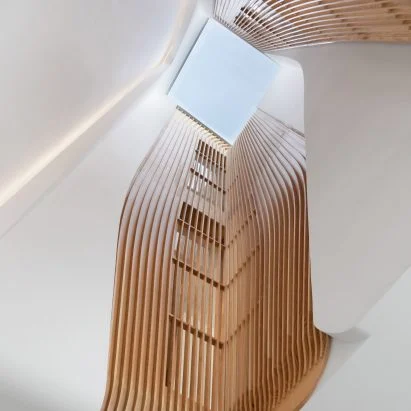For as long as I can remember, I’ve been obsessed with light—especially natural light. There’s something about the warmth of sunlight streaming into a room that instantly makes it feel more open, inviting, and alive. But let’s be honest, not all interior spaces are blessed with an abundance of natural light. When you live or work in a building with few windows, it can feel like you’re trapped in a cave.
That’s where light wells come in. These simple yet powerful design features can work wonders in brightening up even the darkest rooms. I first encountered the idea of a light well when visiting a friend’s apartment in the city. Despite being in a building surrounded by other structures, the apartment felt light and airy, thanks to a strategically placed light well. I was amazed at how such a small change could have such a big impact.
In this article, I’ll walk you through how light wells work, the benefits they provide, and tips for incorporating them into your space to maximize natural light. Whether you’re renovating or designing from scratch, this could be the game-changer you need for a brighter, more welcoming home or office.
1. What is a Light Well?

Understanding the Concept of Light Wells
At its core, a light well is a vertical shaft or opening that allows natural light to penetrate into the interior of a building. Think of it as a skylight, but instead of being on the roof, it’s typically positioned in an enclosed courtyard or between floors. Light wells are often used in spaces that might otherwise lack sufficient natural light, such as inner rooms or basements that are surrounded by other buildings.
I remember walking into a friend’s studio apartment and immediately feeling the difference a light well can make. Despite the apartment being surrounded by tall buildings, the central area was flooded with light thanks to a well-placed opening that reached up to the roof. It was like stepping into a completely different world compared to the dark, windowless hallway I had just walked through.
In a nutshell, light wells provide an elegant solution to the challenge of bringing sunlight into areas that may not have direct access to exterior windows. They’re not only functional but also contribute to the aesthetics and ambiance of a space.
2. The Benefits of Light Wells
Maximizing Natural Light in Dark Spaces
One of the primary reasons for incorporating light wells into interior spaces is to maximize natural light. We all know the benefits of sunlight—it boosts mood, improves productivity, and enhances the overall atmosphere of a room. When I lived in an apartment with limited windows, I could immediately tell the difference when the sun came up and streamed into the living room. Suddenly, the space felt bigger, more open, and much more inviting.
Here are a few benefits of light wells:
-
Brightens Enclosed Spaces: Whether it’s a bathroom, hallway, or inner room, light wells can transform dark spaces into bright, airy ones. I’ve seen rooms with little to no natural light completely transformed with a strategically placed light well.
-
Improves Air Circulation: Because light wells typically bring light into enclosed spaces, they can also help improve air flow. In my experience, this can make a room feel fresher and more comfortable, especially if you include ventilation systems or windows at the top of the light well.
-
Energy Efficiency: By maximizing natural light, light wells can reduce the need for artificial lighting during the day, lowering energy consumption. This is especially valuable in spaces where you spend a lot of time, like kitchens or home offices.
-
Enhanced Aesthetics: Light wells can also add a striking visual element to a room. They provide depth and interest, creating a focal point that adds personality to the space. I’ve seen well-designed light wells that serve as architectural features, bringing both light and style to a room.
3. How Light Wells Work: The Design and Structure
The Mechanics of Light Wells
So, how exactly do light wells bring in natural light? It’s all about design and positioning. Typically, light wells are designed as vertical shafts that allow light to travel down from a roof or upper level into a lower level or interior space. The width, depth, and placement of the light well are all factors that determine how much light can enter the space.
Here’s what you need to know about how light wells work:
-
Shape and Size: The larger and more open the light well, the more light it can allow into the space. Narrow or deep light wells may limit the amount of light that reaches the interior. I’ve seen beautiful light wells that were designed with wide, open areas to allow sunlight to flood into the room below. On the flip side, I’ve also encountered light wells that were too narrow and didn’t provide the desired effect.
-
Top Opening: The top opening of the light well plays a crucial role in the amount of sunlight it lets in. If the light well is located between buildings or surrounded by tall structures, the amount of light it receives may be limited during certain parts of the day. However, positioning the light well in a way that maximizes exposure to the sun (like facing south or west) can increase the light that enters.
-
Reflective Surfaces: Some light wells use reflective surfaces, such as mirrors or polished materials, to direct light further into the room. I’ve seen clever uses of mirrors placed on the walls of light wells to bounce sunlight deeper into a room, brightening areas that would otherwise remain dark.
4. Designing Your Own Light Well: Practical Tips
How to Incorporate a Light Well Into Your Home or Office
If you’re considering installing a light well in your home or office, there are a few design principles that can help you maximize its effectiveness:
-
Assess the Space: Before committing to a light well, assess the space you want to brighten. Is it an interior room with no access to natural light? Is it an area that could benefit from more air circulation? In my case, I found that light wells worked wonders in spaces like bathrooms or hallways where natural light was scarce.
-
Consider Ventilation: If you want to improve air flow in the space as well, consider adding windows or vents at the top of the light well. This can help create a cross-breeze and keep the room feeling fresh. For instance, adding a small vent to the top of a bathroom light well can help prevent moisture buildup.
-
Choose the Right Materials: When designing a light well, choose materials that enhance light reflection and distribution. Reflective finishes, glass panels, or light-colored walls can help amplify the amount of light entering the space. I’ve seen homes with glass ceilings that allow sunlight to filter down into the lower levels, creating a bright and open feel.
-
Integrate with Landscaping: If your light well is outdoors or accessible through a courtyard, consider integrating it with landscaping. Plants or small trees around the light well can provide additional visual interest and soften the space.
5. Light Wells in Architecture: Examples from Around the World
Inspiring Light Well Designs
I’ve always been fascinated by how architects use light wells to create stunning spaces. For example, the Cactus Tower in Copenhagen incorporates light wells in its design to bring natural light into the building’s interior, even in areas that are surrounded by other structures. Similarly, in urban areas where buildings are tightly packed, light wells have become a popular way to ensure that even inner rooms receive ample light.
Incorporating light wells into modern architecture can also serve as a sustainable design choice, reducing the reliance on artificial lighting. In fact, many eco-conscious architects use light wells as part of their energy-efficient designs to create bright, airy spaces with minimal environmental impact.
Conclusion: Light Wells as the Key to Brighter, Healthier Spaces
Light wells are a simple yet powerful way to bring natural light into your home or office, improving not only the look of your space but also your well-being. By carefully considering design, materials, and placement, you can maximize the benefits of these architectural features and create a bright, welcoming environment.
If you’re looking to transform dark, closed-off spaces into areas full of light and life, a light well could be the perfect solution. Take the time to evaluate your space, plan the design, and watch as the light pours in to change the entire feel of your environment.

